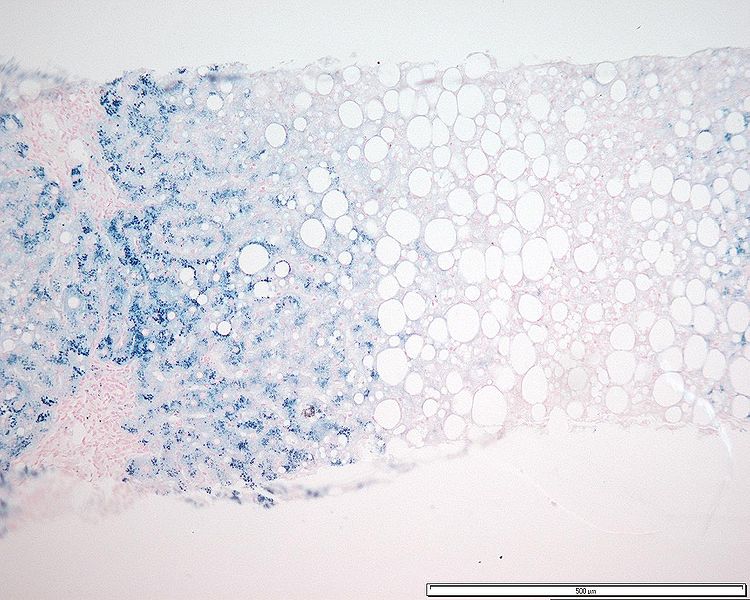Playlist
Show Playlist
Hide Playlist
Hereditary Hemochromatosis with Case
-
Slides Gastroenterology 12 Liver Pt2 NAFLD.pdf
-
Reference List Gastroenterology.pdf
-
Download Lecture Overview
00:02 Let's move on to our next case. 00:04 A 45-year-old man with recently diagnosed type 2 diabetes presents to clinic with fatigue, weakness and arthralgias affecting both his hands for the past 6 months. 00:16 He has also noticed that his skin is darkening, although he has not had excess sun exposure. 00:23 He went to urgent care one month ago with the same symptoms and had lab studies that incidentally showed a severely elevated iron level, high ferritin and elevated transferrin saturation. 00:35 An abdominal ultrasound shows hepatomegaly but no cirrhosis. 00:40 What is the best recommended treatment for his condition? So, he has a recent diagnosis of type 2 diabetes. 00:50 He has some vague symptoms of fatigue, weakness and some joint pain as well as changes in his skin that suggest a systemic disorder And his labs are concerning for iron overload with his high iron level and high ferritin. 01:09 So, let's talk a bit about hereditary hemochromatosis. 01:13 This is a rare disease but is commonly tested. 01:17 It is autosomal recessive in its inheritance and it is from excess iron absorption which leads to iron overload and deposition in various tissues including the liver. 01:30 The diagnosis is made by looking for characteristic symptoms. 01:34 Finding labs consistent with iron overload - so high serum iron, ferritin and transferrin saturation. 01:43 And the gold standard for diagnosis is genetic testing for this particular mutation that we know is associated with hereditary hemochromatosis. 01:51 The treatment is with phlebotomy for iron overload. 01:58 So the clinical features of this disease are quite broad. 02:01 We can think about it anatomically. 02:03 So first, if iron deposition occurs in the brain or the pituitary gland, patients may develop chronic fatigue and hypopituitarism. 02:13 Of course it often affects the liver leading to an enlarged liver or cirrhosis and eventually the potential for hepatocellular carcinoma. 02:23 Patients may also complain of dry skin and skin that is darkening in color or melanoderma. 02:33 When iron infiltrates into the heart tissues, this can lead to cardiac arrhythmias and heart failure. 02:40 When deposition occurs in the pancreas, patients may develop new diabetes. 02:47 They may also have nail changes with white nails or flat nails otherwise known as koilonychia and they may also develop joint pain and osteoporosis. 02:57 So putting this all together, if you're encountered with a patient who has recently diagnosed with type 2 diabetes, has some form of liver disease and is now finding that their skin is turning bronze color or darkening, then you should think about hereditary hemochromatosis. 03:17 The diagnosis should be done early to avoid any of the end-organ complications. 03:23 You should also offer genetic counseling for any patients and their families if you suspect this diagnosis. 03:30 And one more quick high-yield point is that any patients with this condition should be counseled to avoid eating raw seafood or undercooked pork because in states of iron overload, they have a higher incidence of particular infections with vibrio and yersinia so they should avoid these types of foods. 03:52 So now we can return to our case. 03:54 A 45-year-old man with recently diagnosed type 2 diabetes, he has vague symptoms of some type of systemic disorder. 04:02 His labs show iron overload. 04:04 So now putting it all together, his constellation of symptoms and his lab findings should make you consider hemochromatosis. 04:11 So the best recommended treatment for his condition is periodic phlebotomy. 04:16 Note also that at this point, he does not yet have cirrhosis but he has other signs of end organ damage with his diabetes, his melanoderma or skin darkening and his joint pain or arthralgias. 04:29 So you should treat at this point. 04:34 Thank you very much.
About the Lecture
The lecture Hereditary Hemochromatosis with Case by Kelley Chuang, MD is from the course Disorders of the Hepatobiliary Tract.
Included Quiz Questions
Which of the following is one of the clinical features of hemochromatosis?
- Heart failure
- Hyperpituitarism
- Blue nails
- Dysarthria
- Anemia
Which of the following is the gold standard for the diagnosis of hemochromatosis?
- Genetic testing for the C282Y mutation
- Serum iron studies
- Liver biopsy
- Liver MRI
- Liver ultrasonography
Customer reviews
5,0 of 5 stars
| 5 Stars |
|
1 |
| 4 Stars |
|
0 |
| 3 Stars |
|
0 |
| 2 Stars |
|
0 |
| 1 Star |
|
0 |
this is a clear and concise explanation and learning through cases is very useful




